Business Management Case Study: Embraer and Currency Risks
VerifiedAdded on 2022/08/13
|5
|1375
|17
Case Study
AI Summary
This case study analyzes the business management strategies of Embraer, focusing on the impact of economic factors and exchange rate fluctuations on the company's financial performance. The study examines Brazil's economic history, including inflation and exchange rate volatility, and how these factors have influenced Embraer's operations. It explores the risks associated with the Brazilian real and its impact on the company's costs, pricing, and profitability. The analysis evaluates Embraer's decisions, such as hedging strategies, and assesses their effectiveness in mitigating currency risks. Furthermore, the study provides alternative approaches Embraer could have taken to manage its financial exposure, particularly during periods of depreciation. The case study concludes by examining the impact of currency depreciation between 2014 and early 2015 on Embraer's performance, highlighting the importance of financial policies in countries with unstable economic conditions.
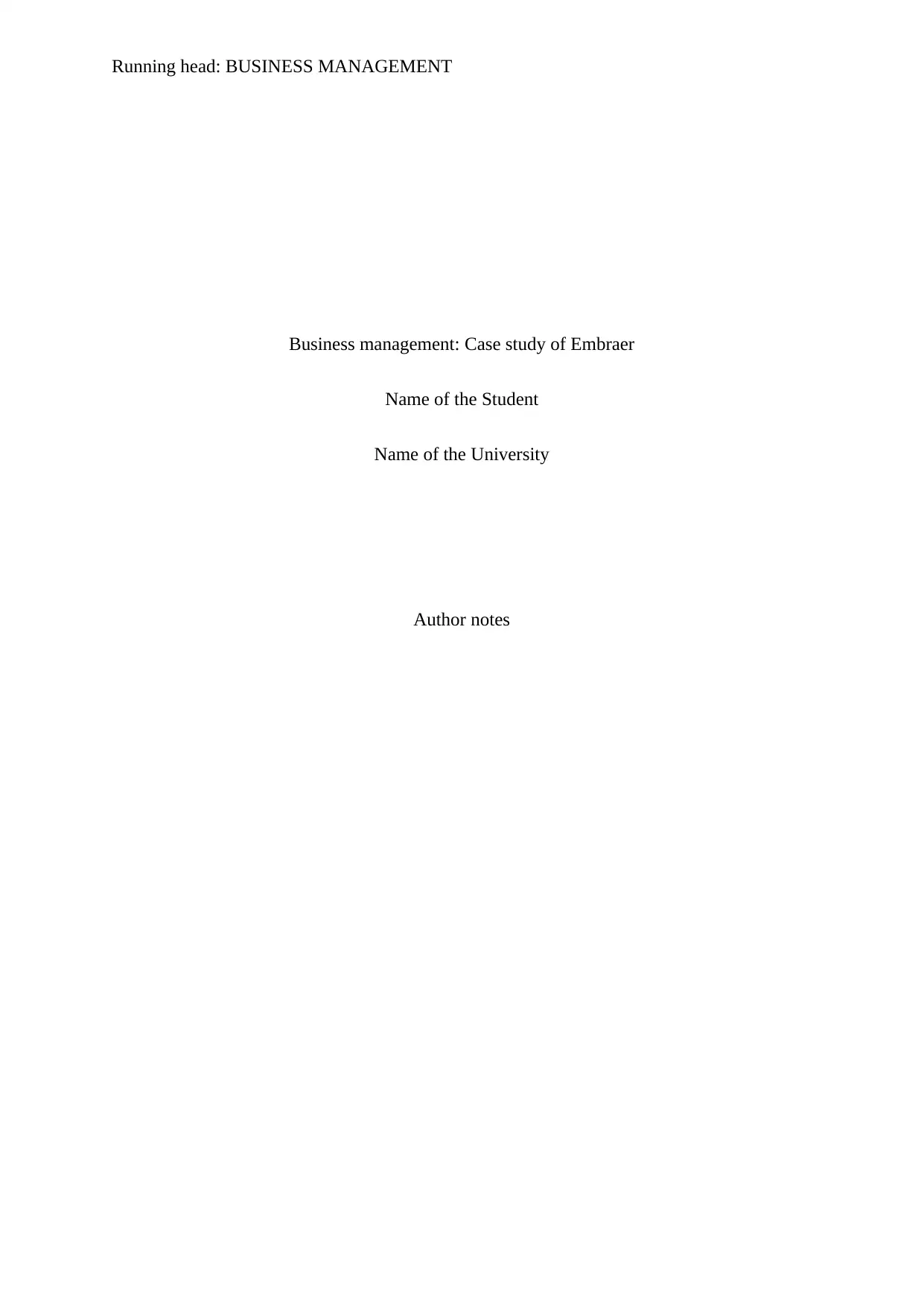
Running head: BUSINESS MANAGEMENT
Business management: Case study of Embraer
Name of the Student
Name of the University
Author notes
Business management: Case study of Embraer
Name of the Student
Name of the University
Author notes
Paraphrase This Document
Need a fresh take? Get an instant paraphrase of this document with our AI Paraphraser
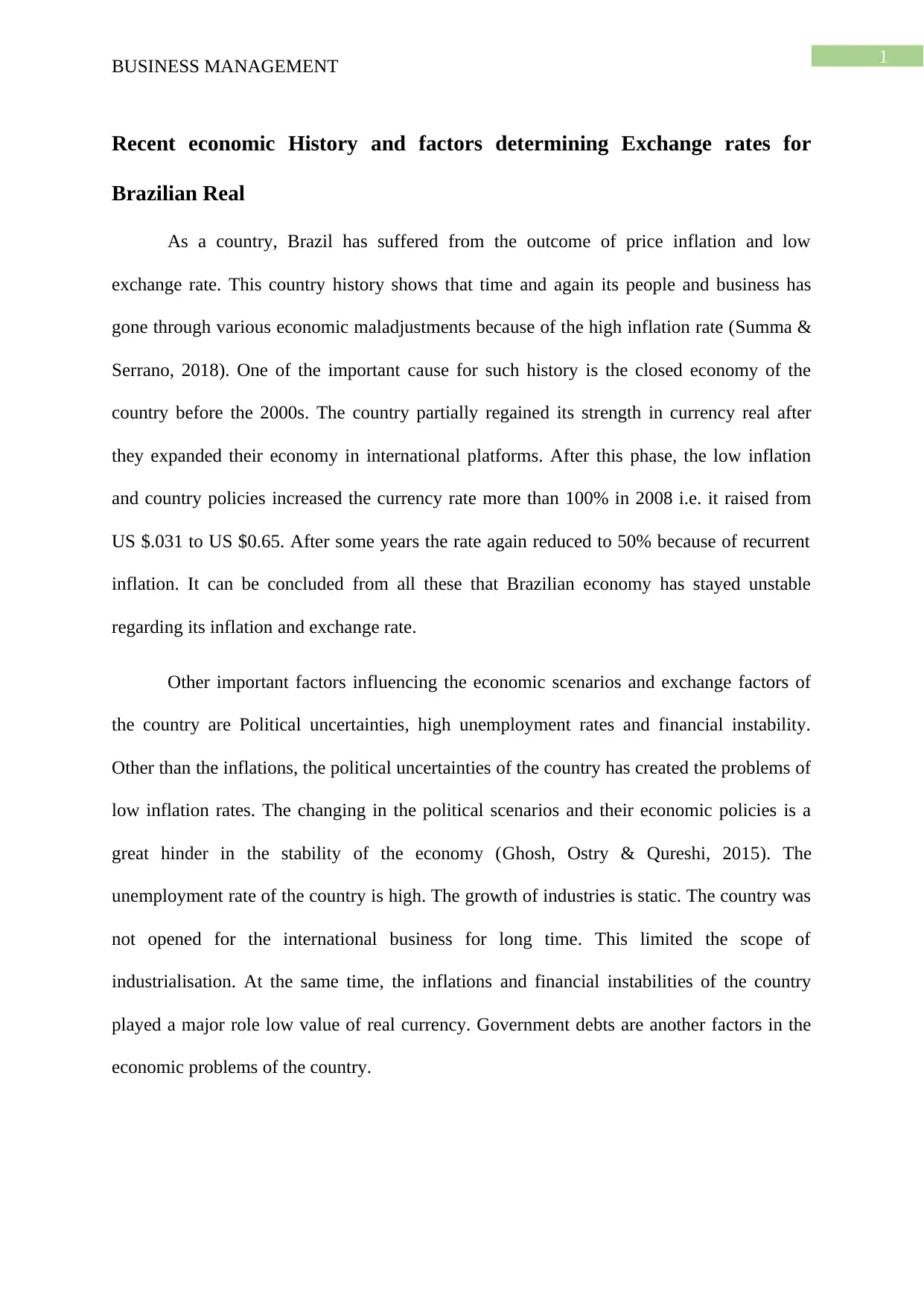
1
BUSINESS MANAGEMENT
Recent economic History and factors determining Exchange rates for
Brazilian Real
As a country, Brazil has suffered from the outcome of price inflation and low
exchange rate. This country history shows that time and again its people and business has
gone through various economic maladjustments because of the high inflation rate (Summa &
Serrano, 2018). One of the important cause for such history is the closed economy of the
country before the 2000s. The country partially regained its strength in currency real after
they expanded their economy in international platforms. After this phase, the low inflation
and country policies increased the currency rate more than 100% in 2008 i.e. it raised from
US $.031 to US $0.65. After some years the rate again reduced to 50% because of recurrent
inflation. It can be concluded from all these that Brazilian economy has stayed unstable
regarding its inflation and exchange rate.
Other important factors influencing the economic scenarios and exchange factors of
the country are Political uncertainties, high unemployment rates and financial instability.
Other than the inflations, the political uncertainties of the country has created the problems of
low inflation rates. The changing in the political scenarios and their economic policies is a
great hinder in the stability of the economy (Ghosh, Ostry & Qureshi, 2015). The
unemployment rate of the country is high. The growth of industries is static. The country was
not opened for the international business for long time. This limited the scope of
industrialisation. At the same time, the inflations and financial instabilities of the country
played a major role low value of real currency. Government debts are another factors in the
economic problems of the country.
BUSINESS MANAGEMENT
Recent economic History and factors determining Exchange rates for
Brazilian Real
As a country, Brazil has suffered from the outcome of price inflation and low
exchange rate. This country history shows that time and again its people and business has
gone through various economic maladjustments because of the high inflation rate (Summa &
Serrano, 2018). One of the important cause for such history is the closed economy of the
country before the 2000s. The country partially regained its strength in currency real after
they expanded their economy in international platforms. After this phase, the low inflation
and country policies increased the currency rate more than 100% in 2008 i.e. it raised from
US $.031 to US $0.65. After some years the rate again reduced to 50% because of recurrent
inflation. It can be concluded from all these that Brazilian economy has stayed unstable
regarding its inflation and exchange rate.
Other important factors influencing the economic scenarios and exchange factors of
the country are Political uncertainties, high unemployment rates and financial instability.
Other than the inflations, the political uncertainties of the country has created the problems of
low inflation rates. The changing in the political scenarios and their economic policies is a
great hinder in the stability of the economy (Ghosh, Ostry & Qureshi, 2015). The
unemployment rate of the country is high. The growth of industries is static. The country was
not opened for the international business for long time. This limited the scope of
industrialisation. At the same time, the inflations and financial instabilities of the country
played a major role low value of real currency. Government debts are another factors in the
economic problems of the country.
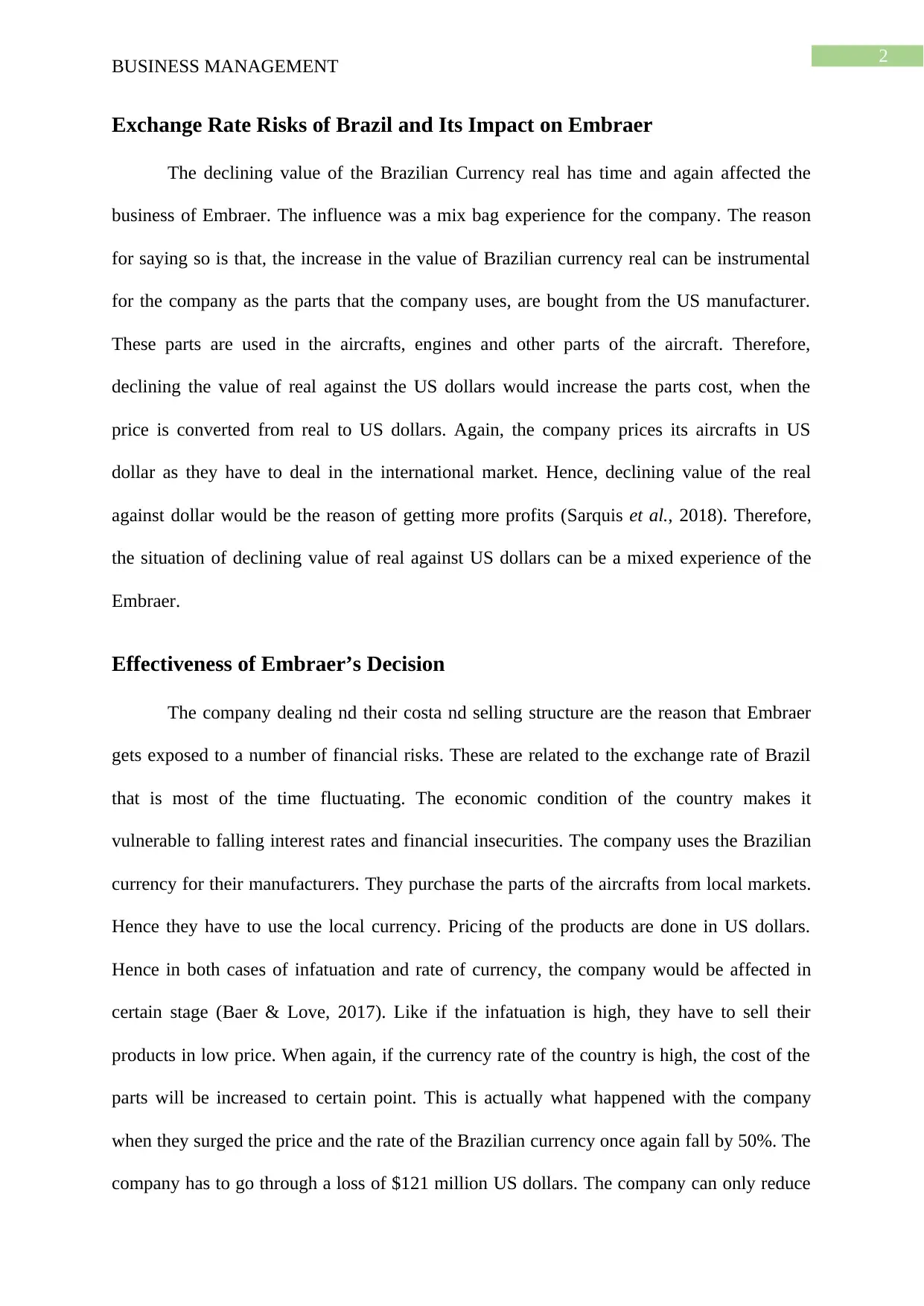
2
BUSINESS MANAGEMENT
Exchange Rate Risks of Brazil and Its Impact on Embraer
The declining value of the Brazilian Currency real has time and again affected the
business of Embraer. The influence was a mix bag experience for the company. The reason
for saying so is that, the increase in the value of Brazilian currency real can be instrumental
for the company as the parts that the company uses, are bought from the US manufacturer.
These parts are used in the aircrafts, engines and other parts of the aircraft. Therefore,
declining the value of real against the US dollars would increase the parts cost, when the
price is converted from real to US dollars. Again, the company prices its aircrafts in US
dollar as they have to deal in the international market. Hence, declining value of the real
against dollar would be the reason of getting more profits (Sarquis et al., 2018). Therefore,
the situation of declining value of real against US dollars can be a mixed experience of the
Embraer.
Effectiveness of Embraer’s Decision
The company dealing nd their costa nd selling structure are the reason that Embraer
gets exposed to a number of financial risks. These are related to the exchange rate of Brazil
that is most of the time fluctuating. The economic condition of the country makes it
vulnerable to falling interest rates and financial insecurities. The company uses the Brazilian
currency for their manufacturers. They purchase the parts of the aircrafts from local markets.
Hence they have to use the local currency. Pricing of the products are done in US dollars.
Hence in both cases of infatuation and rate of currency, the company would be affected in
certain stage (Baer & Love, 2017). Like if the infatuation is high, they have to sell their
products in low price. When again, if the currency rate of the country is high, the cost of the
parts will be increased to certain point. This is actually what happened with the company
when they surged the price and the rate of the Brazilian currency once again fall by 50%. The
company has to go through a loss of $121 million US dollars. The company can only reduce
BUSINESS MANAGEMENT
Exchange Rate Risks of Brazil and Its Impact on Embraer
The declining value of the Brazilian Currency real has time and again affected the
business of Embraer. The influence was a mix bag experience for the company. The reason
for saying so is that, the increase in the value of Brazilian currency real can be instrumental
for the company as the parts that the company uses, are bought from the US manufacturer.
These parts are used in the aircrafts, engines and other parts of the aircraft. Therefore,
declining the value of real against the US dollars would increase the parts cost, when the
price is converted from real to US dollars. Again, the company prices its aircrafts in US
dollar as they have to deal in the international market. Hence, declining value of the real
against dollar would be the reason of getting more profits (Sarquis et al., 2018). Therefore,
the situation of declining value of real against US dollars can be a mixed experience of the
Embraer.
Effectiveness of Embraer’s Decision
The company dealing nd their costa nd selling structure are the reason that Embraer
gets exposed to a number of financial risks. These are related to the exchange rate of Brazil
that is most of the time fluctuating. The economic condition of the country makes it
vulnerable to falling interest rates and financial insecurities. The company uses the Brazilian
currency for their manufacturers. They purchase the parts of the aircrafts from local markets.
Hence they have to use the local currency. Pricing of the products are done in US dollars.
Hence in both cases of infatuation and rate of currency, the company would be affected in
certain stage (Baer & Love, 2017). Like if the infatuation is high, they have to sell their
products in low price. When again, if the currency rate of the country is high, the cost of the
parts will be increased to certain point. This is actually what happened with the company
when they surged the price and the rate of the Brazilian currency once again fall by 50%. The
company has to go through a loss of $121 million US dollars. The company can only reduce
⊘ This is a preview!⊘
Do you want full access?
Subscribe today to unlock all pages.

Trusted by 1+ million students worldwide
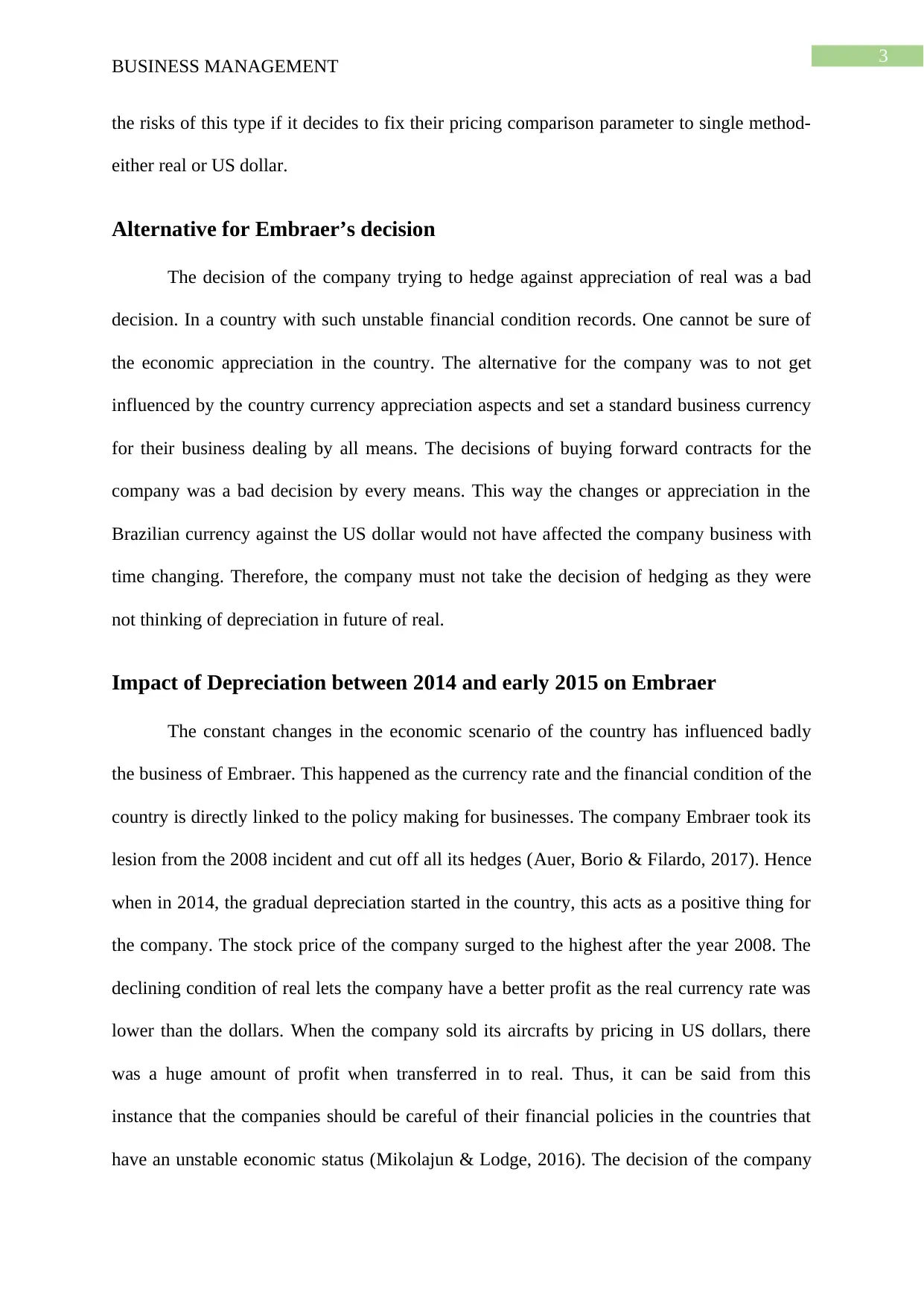
3
BUSINESS MANAGEMENT
the risks of this type if it decides to fix their pricing comparison parameter to single method-
either real or US dollar.
Alternative for Embraer’s decision
The decision of the company trying to hedge against appreciation of real was a bad
decision. In a country with such unstable financial condition records. One cannot be sure of
the economic appreciation in the country. The alternative for the company was to not get
influenced by the country currency appreciation aspects and set a standard business currency
for their business dealing by all means. The decisions of buying forward contracts for the
company was a bad decision by every means. This way the changes or appreciation in the
Brazilian currency against the US dollar would not have affected the company business with
time changing. Therefore, the company must not take the decision of hedging as they were
not thinking of depreciation in future of real.
Impact of Depreciation between 2014 and early 2015 on Embraer
The constant changes in the economic scenario of the country has influenced badly
the business of Embraer. This happened as the currency rate and the financial condition of the
country is directly linked to the policy making for businesses. The company Embraer took its
lesion from the 2008 incident and cut off all its hedges (Auer, Borio & Filardo, 2017). Hence
when in 2014, the gradual depreciation started in the country, this acts as a positive thing for
the company. The stock price of the company surged to the highest after the year 2008. The
declining condition of real lets the company have a better profit as the real currency rate was
lower than the dollars. When the company sold its aircrafts by pricing in US dollars, there
was a huge amount of profit when transferred in to real. Thus, it can be said from this
instance that the companies should be careful of their financial policies in the countries that
have an unstable economic status (Mikolajun & Lodge, 2016). The decision of the company
BUSINESS MANAGEMENT
the risks of this type if it decides to fix their pricing comparison parameter to single method-
either real or US dollar.
Alternative for Embraer’s decision
The decision of the company trying to hedge against appreciation of real was a bad
decision. In a country with such unstable financial condition records. One cannot be sure of
the economic appreciation in the country. The alternative for the company was to not get
influenced by the country currency appreciation aspects and set a standard business currency
for their business dealing by all means. The decisions of buying forward contracts for the
company was a bad decision by every means. This way the changes or appreciation in the
Brazilian currency against the US dollar would not have affected the company business with
time changing. Therefore, the company must not take the decision of hedging as they were
not thinking of depreciation in future of real.
Impact of Depreciation between 2014 and early 2015 on Embraer
The constant changes in the economic scenario of the country has influenced badly
the business of Embraer. This happened as the currency rate and the financial condition of the
country is directly linked to the policy making for businesses. The company Embraer took its
lesion from the 2008 incident and cut off all its hedges (Auer, Borio & Filardo, 2017). Hence
when in 2014, the gradual depreciation started in the country, this acts as a positive thing for
the company. The stock price of the company surged to the highest after the year 2008. The
declining condition of real lets the company have a better profit as the real currency rate was
lower than the dollars. When the company sold its aircrafts by pricing in US dollars, there
was a huge amount of profit when transferred in to real. Thus, it can be said from this
instance that the companies should be careful of their financial policies in the countries that
have an unstable economic status (Mikolajun & Lodge, 2016). The decision of the company
Paraphrase This Document
Need a fresh take? Get an instant paraphrase of this document with our AI Paraphraser
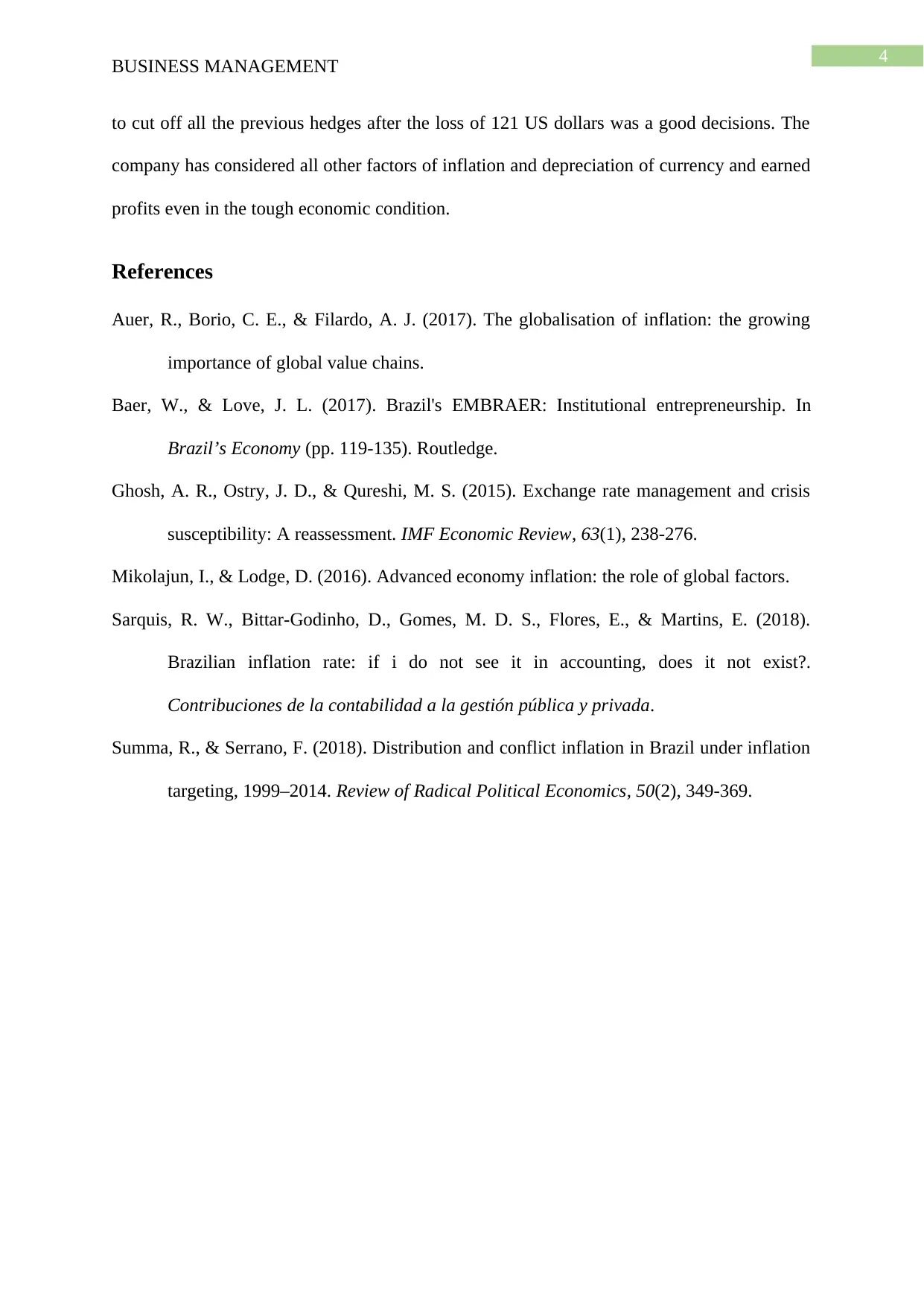
4
BUSINESS MANAGEMENT
to cut off all the previous hedges after the loss of 121 US dollars was a good decisions. The
company has considered all other factors of inflation and depreciation of currency and earned
profits even in the tough economic condition.
References
Auer, R., Borio, C. E., & Filardo, A. J. (2017). The globalisation of inflation: the growing
importance of global value chains.
Baer, W., & Love, J. L. (2017). Brazil's EMBRAER: Institutional entrepreneurship. In
Brazil’s Economy (pp. 119-135). Routledge.
Ghosh, A. R., Ostry, J. D., & Qureshi, M. S. (2015). Exchange rate management and crisis
susceptibility: A reassessment. IMF Economic Review, 63(1), 238-276.
Mikolajun, I., & Lodge, D. (2016). Advanced economy inflation: the role of global factors.
Sarquis, R. W., Bittar-Godinho, D., Gomes, M. D. S., Flores, E., & Martins, E. (2018).
Brazilian inflation rate: if i do not see it in accounting, does it not exist?.
Contribuciones de la contabilidad a la gestión pública y privada.
Summa, R., & Serrano, F. (2018). Distribution and conflict inflation in Brazil under inflation
targeting, 1999–2014. Review of Radical Political Economics, 50(2), 349-369.
BUSINESS MANAGEMENT
to cut off all the previous hedges after the loss of 121 US dollars was a good decisions. The
company has considered all other factors of inflation and depreciation of currency and earned
profits even in the tough economic condition.
References
Auer, R., Borio, C. E., & Filardo, A. J. (2017). The globalisation of inflation: the growing
importance of global value chains.
Baer, W., & Love, J. L. (2017). Brazil's EMBRAER: Institutional entrepreneurship. In
Brazil’s Economy (pp. 119-135). Routledge.
Ghosh, A. R., Ostry, J. D., & Qureshi, M. S. (2015). Exchange rate management and crisis
susceptibility: A reassessment. IMF Economic Review, 63(1), 238-276.
Mikolajun, I., & Lodge, D. (2016). Advanced economy inflation: the role of global factors.
Sarquis, R. W., Bittar-Godinho, D., Gomes, M. D. S., Flores, E., & Martins, E. (2018).
Brazilian inflation rate: if i do not see it in accounting, does it not exist?.
Contribuciones de la contabilidad a la gestión pública y privada.
Summa, R., & Serrano, F. (2018). Distribution and conflict inflation in Brazil under inflation
targeting, 1999–2014. Review of Radical Political Economics, 50(2), 349-369.
1 out of 5
Related Documents
Your All-in-One AI-Powered Toolkit for Academic Success.
+13062052269
info@desklib.com
Available 24*7 on WhatsApp / Email
![[object Object]](/_next/static/media/star-bottom.7253800d.svg)
Unlock your academic potential
Copyright © 2020–2025 A2Z Services. All Rights Reserved. Developed and managed by ZUCOL.





